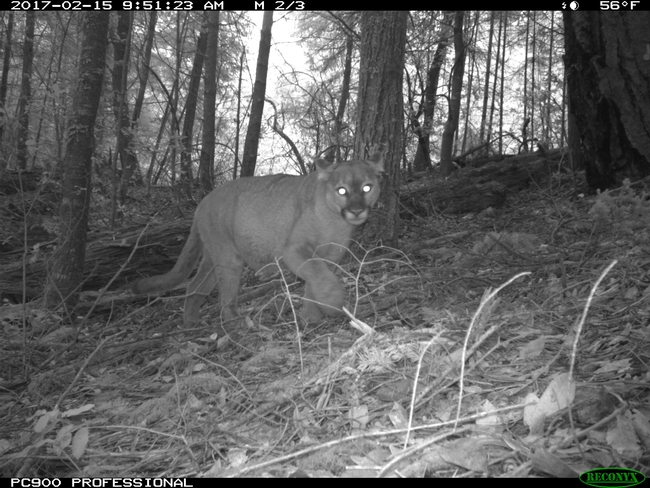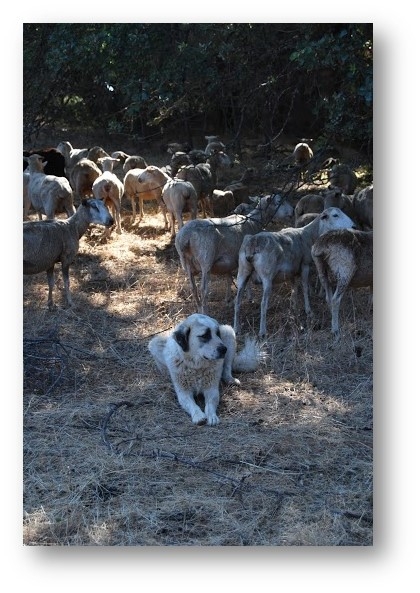As in much of the world, carnivores and grazing livestock in our four-county region (Placer, Nevada, Sutter and Yuba) share the many of the same rangeland habitats. In some cases, land use conversion of rangelands - often to urban or suburban development - concentrates livestock and predators on a shrinking landscape - making conflict inevitable (see Zimmerman et al., 2010).
As many ranchers know, the main predators of sheep, goats and cattle in our region are coyotes, mountain lions, black bears and domestic dogs. In the last several years, gray wolves have come back into northern California. The California Department of Fish and Wildlife (CDFW) recently collared a female member of the newly named "Lassen Pack," apparently in the mountains somewhere west of Susanville. Gray wolves in California are protected under both the state and federal endangered species acts; lethal control of gray wolves is not an option in California. CDFW anticipates that gray wolves will eventually move as far south as I-80 in the Sierra Nevada and Mendocino County in the Coast Range.
Closer to home, I attended a meeting of the Sutter-Yuba Farm Bureau this week, which featured a discussion about a mountain lion that was collared and recently spotted in the Sutter Buttes (an area in which such sightings are apparently unusual). Ranchers in the Buttes were legitimately concerned about the safety of their livestock. While mountain lions are a specially protected species in California, ranchers can obtain depredation permits if a mountain lion has killed livestock. According to CDFW, if you suspect lion depredation, you should preserve the carcass and scene (by placing a tarp over the carcass, covering tracks with cans or buckets, and minimizing disturbance). Call your nearest CDFW office or local Wildlife Services specialist (or county specialist in Placer County). If a lion kill is confirmed, CDFW will issue a depredation permit. See below for contact information for these agencies.
Livestock protection tools - guardian dogs, electric fencing, increased human presence (to name a few) - can offer site- and operation-specific protection for grazing livestock. Along with a number of campus-based specialists and other farm advisors from through northern California, I have been working on a new publication that will help ranchers (and others) evaluate these tools for their own operations. We hope the publication will be available this fall. We will also be launching a livestock-carnivore information hub on the UC Rangelands website. Stay tuned!
Finally, we have also initiated a long-term survey to evaluate the direct and indirect impacts of predators on rangeland livestock operations. This study, which will continue over the next 10 years, will examine direct impacts (death loss) from predators, as well as potential indirect impacts (reduced conception rates, lower weaning weights, increased labor, the cost of nonlethal tools, etc.). If you are a commercial livestock producer who has at least 5 years of records on your operation and who plans to stay in business for at least 10 more years, please contact me if you're interested in participating in this project. My email is dmacon@ucanr.edu.
In the meantime, I have provided a number of links regarding depredation and carnivore-livestock co-existence, as well as contact information for local agency offices.
- California Department of Fish and Wildlife - Region 2 (which includes Placer, Nevada, Sutter and Yuba Counties)
- USDA Wildlife Services - California - the state office can provide contact information for wildlife specialists in your county.
- Placer County Agriculture Department (Placer County employs its own wildlife specialists, who are available to assist with depredation problems)
- National Wildlife Research Center - the research arm of USDA Wildlife Services. The center is conducting a variety of research projects related to livestock-predator interactions.
- CDFW Gray Wolf Conservation Plan
- CDFW Gray Wolf FAQ Sheet for Ranchers - tools for California livestock producers to discourage wolf presence, guidance for suspected wolf depredation, and wolf legal status.